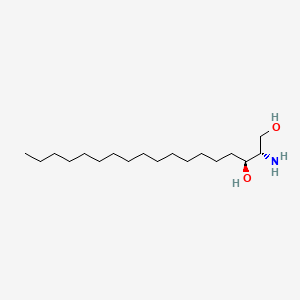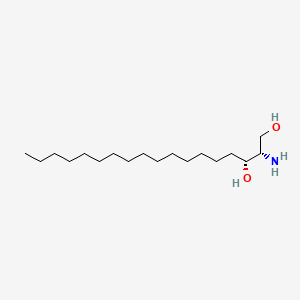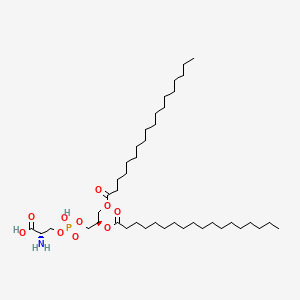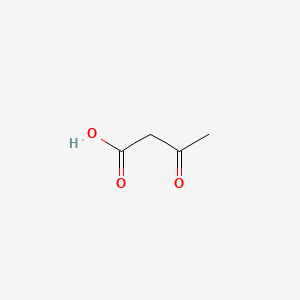
|
SAFINGOL |
Safingol is a lipid of Sphingolipids (SP) class. Safingol is associated with abnormalities such as Wiskott-Aldrich Syndrome. The involved functions are known as Gene Expression, Signal Transduction, Synthesis, Mutation and Adjudication. Safingol often locates in nucleocapsid location. The associated genes with Safingol are Homologous Gene. The related lipids are dihydroceramide and lipid structure. |
181 |

|
PE(15:0/20:0) |
PE(15:0/20:0) is a lipid of Glycerophospholipids (GP) class. Pe(15:0/20:0) is associated with abnormalities such as Exanthema, Infection, Painful Bladder Syndrome, Obesity and Fatty Liver. The involved functions are known as conjugation, Transcription, Genetic, Sinking, Autophagy and Protein Biosynthesis. Pe(15:0/20:0) often locates in membrane fraction, soluble, Membrane, Body tissue and Tissue membrane. The associated genes with PE(15:0/20:0) are GABARAPL2 gene, ATG10 gene, ATG12 gene, SLC33A1 gene and GABARAP gene. The related lipids are Liposomes, Lipopolysaccharides, Phosphatidylserines, Membrane Lipids and Cardiolipins. The related experimental models are Knock-out and Cancer Model. |
723 |

|
Sphinganine |
Sphinganine is a lipid of Sphingolipids (SP) class. Sphinganine is associated with abnormalities such as Sphingolipidoses, CLEFT LIP, CONGENITAL HEALED, Aortic aneurysm, familial thoracic 4, Morphologically altered structure and Atherosclerosis. The involved functions are known as Transcription, Genetic, Signal, Muscle Contraction, biological adaptation to stress and Gene Expression. Sphinganine often locates in Tissue membrane, Membrane, Protoplasm, Plasma membrane and Cytoplasmic. The associated genes with Sphinganine are SLC33A1 gene, HM13 gene, P4HTM gene, SPHK1 gene and SPHK2 gene. The related lipids are Sphingolipids, Phosphatidylserines, Sterols, Fatty Acids and inositolphosphorylceramide. The related experimental models are Mouse Model and Knock-out. |
758 |

|
51446-62-9 |
51446-62-9 is a lipid of Glycerophospholipids (GP) class. 51446-62-9 is associated with abnormalities such as Virus Diseases, Infection, Bacterial Infections, Communicable Diseases and Exanthema. The involved functions are known as Phagocytosis, Obstruction, Binding (Molecular Function), targeting and inhibitors. 51446-62-9 often locates in Head, Clone, Cell membrane, Cell surface and host. The associated genes with 51446-62-9 are Homologous Gene, Orthologous Gene, Fusion Protein, ETV3 gene and Amino Acids, Basic. The related lipids are Phosphatidylserines, Lipopolysaccharides, 1-palmitoyl-2-oleoylphosphatidylethanolamine, beta-amyrin and Membrane Lipids. |
1744 |

|
Acetoacetic acid |
Acetoacetic acid is a lipid of Fatty Acyls (FA) class.Acetoacetic acid is associated with abnormalities such as Dehydration. The involved functions are known as Biochemical Reaction, intracellular signal transduction, fatty acid elongation, Cytokinesis and Mass-to-Charge Ratio. The associated genes with Acetoacetic acid are CFB gene and mersacidin. Acetoacetic acidis associated with Carbon, Acids, Potassium, Acetoacetic acid and Oximes. The related lipids are Nonesterified Fatty Acids and Stearates. |
2523 |

|
(r)-3-hydroxybutanoic acid |
(r)-3-hydroxybutanoic acid is a lipid of Fatty Acyls (FA) class. |
2710 |

|
stearic acid |
stearic acid is a lipid of Fatty Acyls (FA) class. Stearic acid is associated with abnormalities such as Helminthiasis, Exanthema, Chronic disease, Obesity and Dyslipidemias. The involved functions are known as acyltransferase activity, Mutation, Cell division, cell fate and Fatty Acid Metabolism. Stearic acid often locates in membrane fraction, Mouse Liver, Membrane, Body tissue and Endoplasmic reticulum, membrane. The associated genes with stearic acid are Homologous Gene, ACLY gene, Transgenes, FATE1 gene and Alleles. The related lipids are Lysophospholipids, Stearic acid, Fatty Acids, cis-vaccenic acid and Phosphatidylserines. The related experimental models are Knock-out. |
5692 |

|
Azithramycine |
Azithramycine is a lipid of Polyketides (PK) class. Azithramycine is associated with abnormalities such as Respiratory Tract Infections, Pneumonia, Lower respiratory tract infection, Infection and Nonspecific urethritis. The involved functions are known as Lysis, Selection, Genetic, Mutation, Relapse and Adaptation. Azithramycine often locates in Blood, Respiratory System, Genitourinary system, Back and Chest. The associated genes with Azithramycine are Genes, rRNA, Genome, RPL22 gene, OPRM1 gene and tryptic soy broth. The related lipids are Liposomes, Phosphatidylserines, Promega, Lipopolysaccharides and Steroids. The related experimental models are Mouse Model, Knock-out and Tissue Model. |
7835 |

|
clarithromycin |
clarithromycin is a lipid of Polyketides (PK) class. Clarithromycin is associated with abnormalities such as Helicobacter Pylori Infection, Infection, Coinfection, Gastritis and Peptic Ulcer. The involved functions are known as Point Mutation, Increased Sensitivy, Bacterial resistance, urease activity and Mutation. Clarithromycin often locates in Blood, Gastric mucosa, Biopsy sample, Respiratory System and Entire gastrointestinal tract. The associated genes with clarithromycin are Genes, rRNA, rRNA Operon, Genome, HM13 gene and GDF15 gene. The related lipids are 9,11-linoleic acid, Steroids, Lysophosphatidylcholines, Lipopolysaccharides and 4-hydroxycholesterol. The related experimental models are Mouse Model, Knock-out and Experimental Pneumococcal Meningitis. |
10449 |

|
tacrolimus |
Tacrolimus is a lipid of Polyketides (PK) class. Tacrolimus is associated with abnormalities such as Renal glomerular disease. The involved functions are known as inhibitors, Fungicidal activity, Metabolic Inhibition, Excretory function and Dephosphorylation. Tacrolimus often locates in Hepatic, Mitochondrial matrix and Inner mitochondrial membrane. The associated genes with Tacrolimus are RHOA gene and BGN gene. |
12730 |









